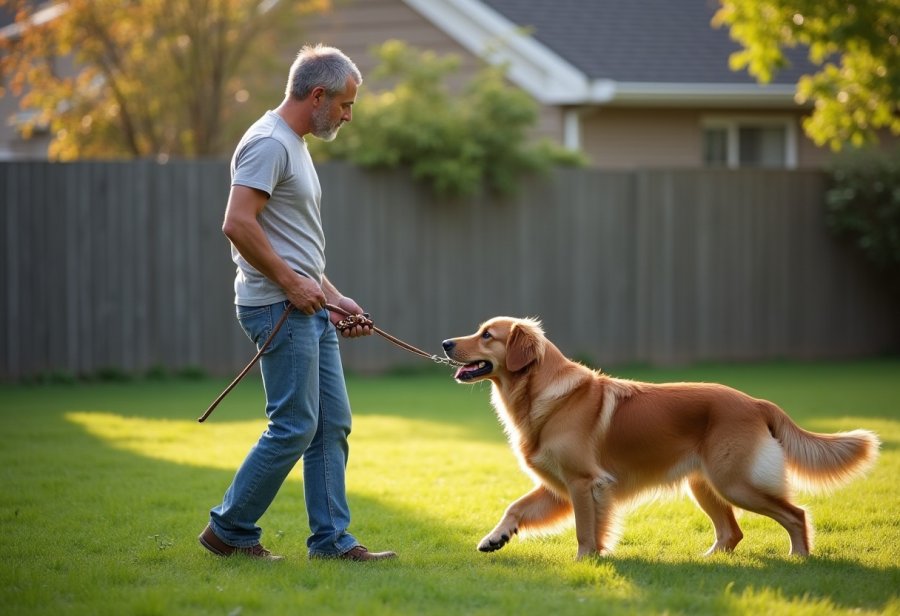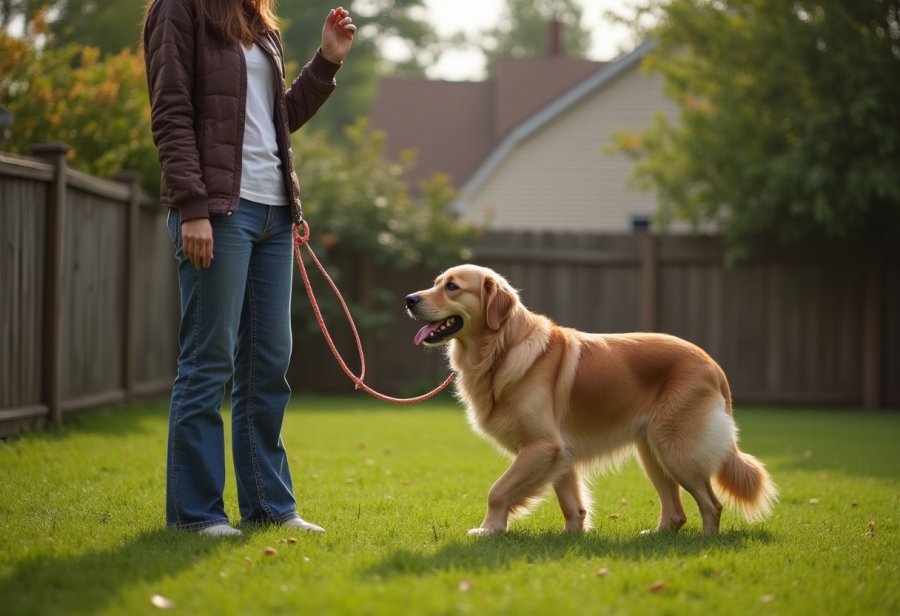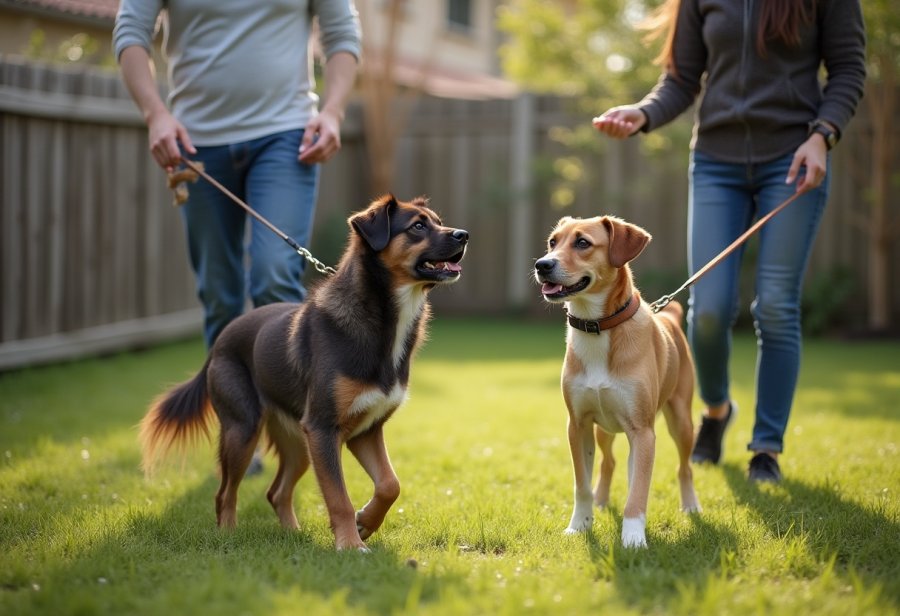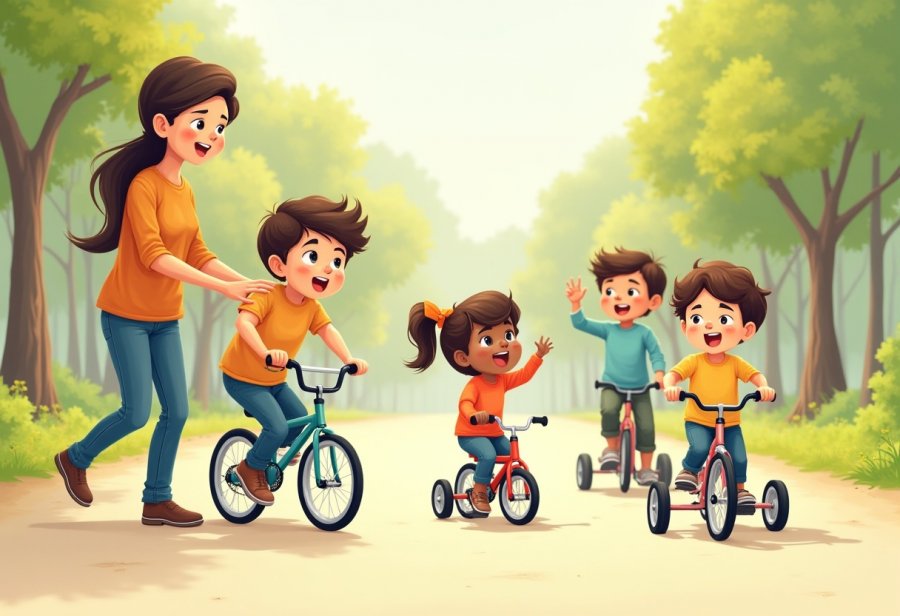Imagine transforming daily walks into peaceful, bonding moments with your dog—can you unlock this calm, mutual understanding? Mastering the art of walking calmly at your side isn’t just about good manners; it’s about fostering trust, reducing stress, and strengthening your relationship. This guide reveals how patience, consistent routines, and positive reinforcement can turn training into a rewarding experience. You’ll discover practical techniques, from choosing the right equipment to managing distractions and setbacks, ensuring your dog learns to stay focused and relaxed. But what happens when unforeseen challenges arise—can you adapt and maintain progress? This comprehensive approach emphasizes gradual exposure, monitoring responses, and using gentle redirection, transforming everyday outings into opportunities for growth. Are you ready to create a shared rhythm that turns routine walks into moments of serene connection, making life safer and more joyful for both of you?

Deepen Your Bond Through Calm Dog Walking
Walking calmly with your dog might seem straightforward, but it’s one of the most meaningful ways to deepen your bond. When your dog learns to walk politely at your side without pulling or jumping, it’s about more than just good manners—it’s about building trust and understanding. These peaceful walks become shared moments of connection, transforming a routine activity into a calming ritual that both of you look forward to.
A relaxed walk also makes outings safer for everyone involved. When your dog moves at your pace, you reduce the risk of accidents, like darting into traffic or getting tangled in the leash. Plus, a calm demeanor helps your dog feel secure, easing anxiety and overexcitement. Over time, this tranquility improves communication, making it easier for your dog to focus and respond to your cues.
Beyond behavior, calm walking nurtures emotional closeness. When your dog senses your confidence and calmness, they tend to mirror that relaxed attitude. This mutual trust forms a solid foundation for training and everyday interactions, creating a more harmonious relationship. Mastering calm walks isn’t just about control; it’s about establishing a shared rhythm that promotes mutual respect and joy.
Building this skill takes patience and consistency, but the rewards are well worth the effort. As your dog begins to respond more calmly during walks, you’ll notice a more attentive and relaxed pet in other areas of life. Turning daily outings into bonding moments transforms a simple activity into a powerful tool for connection and mutual understanding.
Core Principles for Successful Calm Walking
Calm walking with your dog begins with understanding how dogs communicate and respond to their environment. Dogs are highly sensitive to body language, both theirs and yours, so projecting confidence and relaxation signals to your pet encourages calmness. Recognizing early signs of overstimulation—like stiff posture, rapid tail wagging, or tense muscles—lets you respond before excitement escalates. Managing environmental triggers, such as busy streets or loud noises, is essential to maintaining composure. Keeping routines consistent and using clear cues helps your dog understand expectations, reducing stress and confusion.
Positive reinforcement forms the backbone of successful calm walking. Reward your dog immediately when they walk at your side without pulling or reacting to distractions. Treats, praise, or gentle petting create strong associations between calm behavior and positive outcomes. Over time, this consistent feedback makes relaxed walking feel natural rather than forced. Using clear commands like “heel” or “let’s go” helps establish a shared language, guiding your dog with predictability and ease. When your dog responds reliably, both of you enjoy more peaceful, focused walks.
Choosing the right equipment also plays a key role. A front-clip harness or gentle leader offers better control and comfort, making it easier to guide your dog without causing discomfort. Pairing this with a sturdy leash allows gentle redirection and helps prevent pulling or lunging. Building trust is fundamental—when your dog feels safe and confident in your leadership, they’re more willing to stay calm and attentive during walks. Consistent routines, gentle handling, and positive reinforcement foster this trust, making calm walking an achievable goal.
Patience and persistence are vital. Dogs may test boundaries or become distracted, but each moment is an opportunity to reinforce good habits. Maintaining a calm, steady tone—even during setbacks—encourages your dog to mirror your composure. Every successful walk builds your dog’s confidence and focus, gradually turning calmness into a natural state. Remember, this process takes time; consistency and understanding are your best tools for transforming daily walks into peaceful, bonding experiences.
Strategic Techniques to Achieve Peaceful Walks
To develop calmness during walks, start with establishing a consistent routine that your dog can rely on. Short, focused sessions in quiet environments help your dog learn to respond to commands without becoming overwhelmed. As they improve, gradually introduce mild distractions like a busier street or park, always rewarding calm behavior to reinforce your expectations. Practicing at the same times each day helps your dog anticipate what’s coming, making the process smoother and more predictable.
Using treats and praise immediately after good responses strengthens your dog’s understanding that staying focused and calm is rewarding. Keep training sessions brief—around five to ten minutes—to maintain your dog’s engagement and prevent frustration. When your dog pulls or becomes overly excited, pause the walk, wait for the leash to slacken, then continue, redirecting their attention with treats or cues like “heel.” Consistent, gentle corrections teach your dog that calmness is the key to progress.
Choosing the right equipment can make a big difference. A front-clip harness or gentle leader provides better control and comfort, helping prevent pulling without causing discomfort. Pairing this with a sturdy leash allows gentle guidance and quick redirection, which stops minor issues from escalating. Practice commands like “let’s go” or “heel” consistently, rewarding correct responses to create a shared language that keeps walks calm and predictable.
Managing common challenges such as pulling or overexcitement involves calm, quick responses. When your dog tugs, stop and change direction, rewarding them once they return to your side. For distractions, calmly redirect with treats or cues, gradually exposing your dog to more stimulating environments as their focus improves. Patience and steady reinforcement turn setbacks into opportunities for growth.
Modern tools like clickers or remote trainers can support your training efforts by providing immediate feedback, making sessions more engaging. Remember, every walk is a chance to reinforce calm behavior, and with regular practice, your dog will learn to stay relaxed even amid new sights and sounds. Over time, these techniques help turn everyday outings into peaceful, bonding moments that strengthen your relationship.
For additional resources on effective training methods, exploring expert guidance can be highly beneficial. You might find this comprehensive guide on dog training techniques helpful in refining your approach and ensuring peaceful walks become a consistent part of your routine.

Transforming Training into Real-World Success
To put calm walking techniques into real-world practice, start by choosing low-stimulation environments like your backyard or a quiet neighborhood street. These settings allow your dog to focus on your cues without feeling overwhelmed. Keep training sessions short—around five to ten minutes—and always end on a positive note to reinforce good behavior. Consistency in timing and location helps your dog build confidence and understand what’s expected.
Once your dog responds reliably in calm settings, gradually introduce more distractions, such as busier sidewalks or parks. Move slowly and reward calm, focused walking at each stage. If your dog pulls or gets overly excited, pause and redirect their attention with treats or cues like “heel.” This teaches your dog that staying close and calm results in rewards, even in more stimulating environments. Patience is key; rushing into busy settings too soon can cause setbacks.
Using the right equipment, like a front-clip harness, can make a noticeable difference. It offers better control and helps prevent pulling without causing discomfort. Pair this with a sturdy leash to gently guide and redirect your dog. When pulling or distracted, stop and change direction immediately, reinforcing that calmness and attentiveness lead to progress. Incorporate commands like “let’s go” into your routine to make walks more predictable and less stressful.
Address common challenges with a calm, consistent approach. If your dog fixates on something or pulls, calmly redirect with treats or cues. Stay patient; setbacks are just part of the learning process. If your dog becomes overwhelmed, take a short break or move to a quieter spot to reset their focus.
Gradually exposing your dog to more stimulating environments builds resilience and confidence. Always reward calm behavior and avoid harsh corrections. Over time, these practical steps turn everyday walks into successful training moments. Your patience and persistence will help your dog learn to stay relaxed and attentive, making each outing safer and more enjoyable.
Remember to monitor your dog’s responses and adjust your approach as needed. Celebrate small successes, like walking a few extra steps without pulling, to keep both of you motivated. Consistency and positive reinforcement turn calm walking into a natural habit, strengthening your bond and making walks a peaceful, bonding experience.
Applying these strategies regularly transforms routine outings into opportunities for growth and connection. With time and effort, your dog will learn to navigate the world calmly at your side, turning everyday walks into shared moments of peace and joy.
Budget-Friendly Tips for Calm Dog Walking
Training a dog to walk calmly doesn’t have to be a costly endeavor, but understanding the typical expenses helps you plan and stay on track. Essential equipment like a front-clip harness or gentle leader usually ranges from $15 to $40. These tools are worthwhile investments—they make controlling pulling easier and more comfortable for your dog, setting a solid foundation for effective training. Treats and praise are equally vital; having a steady supply of small, high-value rewards keeps your dog motivated and focused during walks.
If you’re seeking expert guidance, professional training sessions or private lessons can accelerate progress. Prices vary, but most professional classes cost between $50 and $150 per session. Group classes tend to be more affordable and add a social element, while private instruction offers tailored advice for specific challenges like stubborn pullers or overexcitement. Investing in these services can significantly improve your training results and save you time in the long run.
Beyond initial training, ongoing reinforcement involves treats, toys, and occasional refresher sessions. These smaller expenses support consistency and help your dog retain good habits over time. Online courses, books, and training apps provide budget-friendly options, often under $50, allowing you to supplement your routine without overspending. Planning your expenses ensures you can maintain a steady training schedule without financial stress.
Community resources like local training groups or free workshops can also be valuable, offering guidance at little to no cost. Balancing quality tools with affordable training methods makes it possible to develop calm walking routines without breaking the bank. Remember, consistent effort and patience matter just as much as money spent; these investments pay off by creating a more peaceful, connected walking experience.
Setting a clear budget helps you stay focused and ensures your training efforts are sustainable. By prioritizing essential equipment and leveraging affordable resources, you can make steady progress without financial overwhelm. This approach keeps your training manageable and reinforces your commitment to a calmer, more confident dog.
Ultimately, the goal is to create a routine that fits your budget while supporting your dog’s growth. Every dollar invested in proper tools and training pays dividends in safety, harmony, and companionship. The key is thoughtful planning—small, consistent investments lead to big, lasting results, turning everyday walks into moments of trust and joy for both of you.
Putting Your Training Plan Into Action and Tracking Progress
To make your training plan effective, start with small, manageable steps. Focus on one goal at a time, like practicing the “heel” command in a quiet space, before gradually adding more distractions. Consistency is key—practicing at the same time each day helps your dog understand expectations and builds a routine your pet can rely on. Keep sessions short, around five to ten minutes, to maintain your dog’s focus and prevent frustration. Tracking progress with notes or a training app makes it easier to see what’s working and where adjustments are needed.
Monitoring your dog’s behavior over time reveals how well they respond to cues, walk calmly, and handle distractions. If your dog pulls or gets overly excited, it’s a sign to pause, reinforce your basics, and then continue. Celebrating small wins, like walking a few extra steps without pulling, keeps both of you motivated. When setbacks happen, view them as opportunities to reinforce good habits rather than failures. Adjust your approach based on your dog’s progress, spending more time in low-stimulation areas if needed.
Regularly revisit your goals, such as walking calmly for a specific distance or in new environments, and celebrate each achievement. This structure keeps your training focused and your dog clear on what success looks like. Remember, training isn’t a quick fix—it’s a gradual process that benefits from patience and consistency. Each session builds your dog’s confidence and focus, turning calm walks into natural, shared routines. By staying attentive and adaptable, you’ll steadily foster a more attentive and relaxed canine companion.
Integrate your training into daily walks by reinforcing cues and rewarding calm behavior even amid distractions. Use the environment as a training ground, gradually increasing difficulty while maintaining a calm, positive tone. Keep a close eye on your dog’s responses, and don’t hesitate to slow down or take a break if needed. This flexibility prevents frustration and helps your dog learn that calmness, not haste, leads to rewards. Over time, these mindful practices turn everyday outings into effective bonding and training opportunities.
Consistency and patience are your best tools. Dogs thrive on routine, and steady reinforcement helps solidify good habits. Track progress by noting improvements and setbacks, adjusting your strategies as your dog evolves. Celebrate small victories—every step forward counts. With persistent effort, the skills your dog learns will become second nature, making walks more enjoyable and less stressful. This ongoing process will strengthen your bond and create a peaceful rhythm that benefits both of you.
Keep in mind that setbacks are normal and part of the learning curve. When challenges arise, stay calm and redirect your dog with gentle cues and positive reinforcement. Sometimes, a change of environment or a brief pause can reset your dog’s focus. Remember, progress isn’t always linear, but with patience and consistency, your dog will learn to stay calm and attentive in a variety of settings. This steady approach transforms training from a chore into a shared journey, fostering trust and a lifetime of peaceful walks.

Preparing for and Managing Setbacks During Training
Training setbacks and unexpected behaviors are a normal part of the learning process, so being prepared helps keep your progress on track. Dogs might get distracted by new sights, sounds, or smells, or test boundaries by pulling harder on the leash or ignoring cues. Recognizing these signs early allows you to respond calmly and prevent issues from escalating. Having a plan—such as moving to a quieter spot, taking a short break, or redirecting their attention—can make a big difference in regaining control.
Environmental triggers like loud noises or unfamiliar surroundings can cause your dog to overreact or become overwhelmed. When this happens, pause the walk, give your dog a moment to settle, and then gradually reintroduce the environment at a calmer pace. This slow exposure helps build resilience and confidence, making your dog better equipped to handle new situations over time. Responding with patience and gentle redirection fosters trust, rather than frustration or harsh corrections, which can increase their anxiety.
Controlling the situation is key. Using tools like a front-clip harness can help guide your dog away from overstimulation without causing discomfort. Keep a short leash handy to make quick adjustments and teach your dog that staying close and calm leads to rewards. When pulling or lunging occurs, stopping and changing direction immediately reinforces that calm, attentive behavior is what earns praise. Consistent, calm reactions teach your dog that they’re safe and supported even amid chaos.
Anticipate common issues like barking or overexcitement by having specific techniques ready. If your dog fixates on something distracting, calmly redirect with treats or cues. When they pull, halt and wait until the leash slackens before moving again. These steady responses prevent setbacks from turning into bigger problems and help your dog learn that calmness is rewarded.
Flexibility makes a big difference. If something isn’t working, try a different approach or take a break. Sometimes, stepping back or moving to a quieter area resets your dog’s mood and refocuses their attention. Progress isn’t always linear, and setbacks are simply part of the process. Staying calm and proactive builds your dog’s resilience, paving the way for more confident, relaxed walks in the future.






